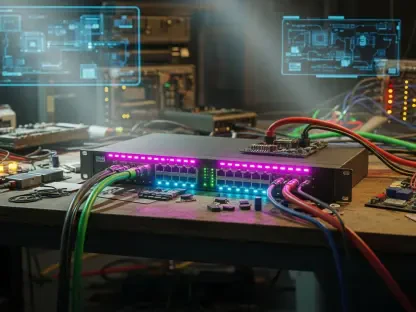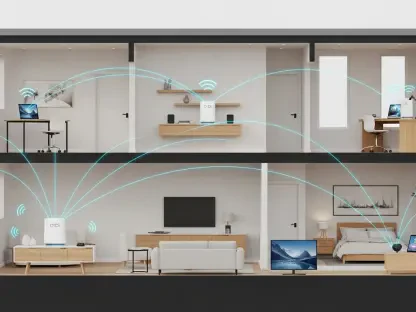In the rapidly evolving domain of industrial automation, communication protocols play a pivotal role in ensuring seamless communication between devices, networks, and systems. They form the backbone of contemporary factory automation systems, facilitating data integration and operational efficiency. As industrial environments grow increasingly complex, the importance of selecting the right communication protocols becomes paramount, directly affecting productivity, scalability, and system performance. This exploration delves into the leading industrial communication protocols, emphasizing their distinct characteristics, market share, and usage trends.
Industrial Ethernet – The Dominant Force
Expanding Presence and Market Share
In the ever-evolving landscape of industrial networks, Industrial Ethernet solidifies itself as the predominant force, showcasing substantial growth and dominance. With a 71% stake in the global market for newly installed nodes, it has experienced a noteworthy 7% increase in applications. This rise signifies its expanding influence and utility in modern industrial environments. The preference for Industrial Ethernet is largely driven by the demand for higher transmission speeds, longer distances, and greater network coverage, which cater to the needs of complex and large-scale industrial operations.
As Industrial Ethernet protocols continue evolving, PROFINET, EtherNet/IP, and EtherCAT emerge as leading contenders, each offering distinct advantages tailored to specific industrial requirements. These protocols demonstrate adaptability and functionality, catering to diverse regional preferences and varying industrial needs. The versatility and compliance of Industrial Ethernet with existing systems underscore its pivotal role in industry, promising future expansion and technological development. Its widespread adoption reflects a broader trend towards high-speed and robust networking solutions in industrial contexts.
Regional Preferences and Protocol Diversity
Industrial Ethernet’s variances in protocol preferences across different regions highlight a movement toward tailored solutions that meet specific industrial needs. In European contexts, PROFINET, developed by PROFIBUS & PROFINET International (PI), is widely implemented. Its ability to integrate seamlessly with PROFIBUS, a legacy serial protocol, ensures compatibility and continuity between older and newer technological infrastructures. This emphasis on compatibility illustrates a pervasive trend of maintaining connections to established systems while adopting technological advances.
Conversely, EtherNet/IP, primarily utilized in the U.S., capitalizes on its efficient integration of the Common Industrial Protocol (CIP) with standard Ethernet technology. Managed by the Open DeviceNet Vendors Association (ODVA), it allows for media-independent communication that’s object-oriented and fine-tuned for industrial automation. This open-source model provides an appealing financial advantage by leveraging cost-effective, standardized communication protocols over proprietary systems. EtherCAT, originating from Beckhoff Automation, distinguishes itself with a unique clock synchronization mechanism, offering high precision and reduced latency. These regional differences and technical distinctions emphasize the adaptability of Industrial Ethernet to various industry-specific needs.
Fieldbus Networks: Niche but Essential
The Continuing Relevance of Fieldbus
Despite the surge in Industrial Ethernet adoption, Fieldbus networks continue to play an essential role where specific requirements dictate their necessity. Accounting for 22% of the global market share, despite a slight decline, Fieldbus remains crucial for applications where compactness, predictability, and deterministic behavior are prioritized. Legacy systems and scenarios with low bandwidth demands benefit greatly from the precision and consistency that Fieldbus networks offer, particularly in motion control and distributed control systems. Its deterministic communication ensures reliable data exchange, pivotal in scenarios demanding accuracy and time-sensitive operations.
While Ethernet’s rapid speed addresses certain limitations of determinism in Fieldbus, the enduring relevance of these networks lies in their ability to provide predictable and tightly controlled communication patterns. This intrinsic reliability in communication is less susceptible to the disruptions that can occur in more dynamic environments, highlighting Fieldbus’s continued importance in particular industrial contexts. As industries evolve, a trend emerges towards hybrid systems that integrate the strengths of both Ethernet and Fieldbus, maximizing efficiency while catering to the unique demands of varied industrial applications.
Specialized Protocols and Legacy Compatibility
Within Fieldbus networks, protocols such as Modbus and PROFIBUS maintain enduring significance due to their robustness in specific environments. Modbus, established in 1979, remains a popular choice because of its simplicity and open-source design. Its cost-effectiveness and uncomplicated implementation make it favorable for applications needing straightforward communication without the complexities of newer protocols. However, limitations arise in terms of data diversity and transfer speeds, as newer Ethernet-based systems surpass Modbus in these areas. Nonetheless, for applications prioritizing cost and simplicity over speed, Modbus remains a valuable tool.
PROFIBUS, maintained by the same organization behind PROFINET, excels in aggregating multiple inputs and outputs for more efficient communications that require less hardware and engineering overhead. Its resilience and reliability in harsh environments make it especially prevalent in European industries. While more rapid than other serial alternatives like Modbus, PROFIBUS’s slower speeds compared to Ethernet highlight its suitability for certain specialized applications over larger-scale operations. Navigating the balance between robustness and complexity emphasizes the criticality of examining application-specific needs in protocol selection.
Conclusion: Navigating the Industrial Protocol Terrain
In the swiftly advancing field of industrial automation, communication protocols are crucial for enabling flawless interaction among devices, systems, and networks. These protocols serve as the foundation of modern factory automation systems, ensuring streamlined data integration and operational success. As industrial landscapes become increasingly intricate, selecting the appropriate communication protocols is essential, as they directly influence productivity, scalability, and overall system efficiency. This discussion examines prominent industrial communication protocols, highlighting their unique features, market presence, and prevailing usage patterns. By understanding and choosing the right protocol, businesses can enhance their automation processes, cope with complex challenges, and maintain competitive advantages. As industry demands evolve, staying informed about these protocols is vital for adapting and thriving in a fast-paced environment where technology continuously reshapes factory operations.









